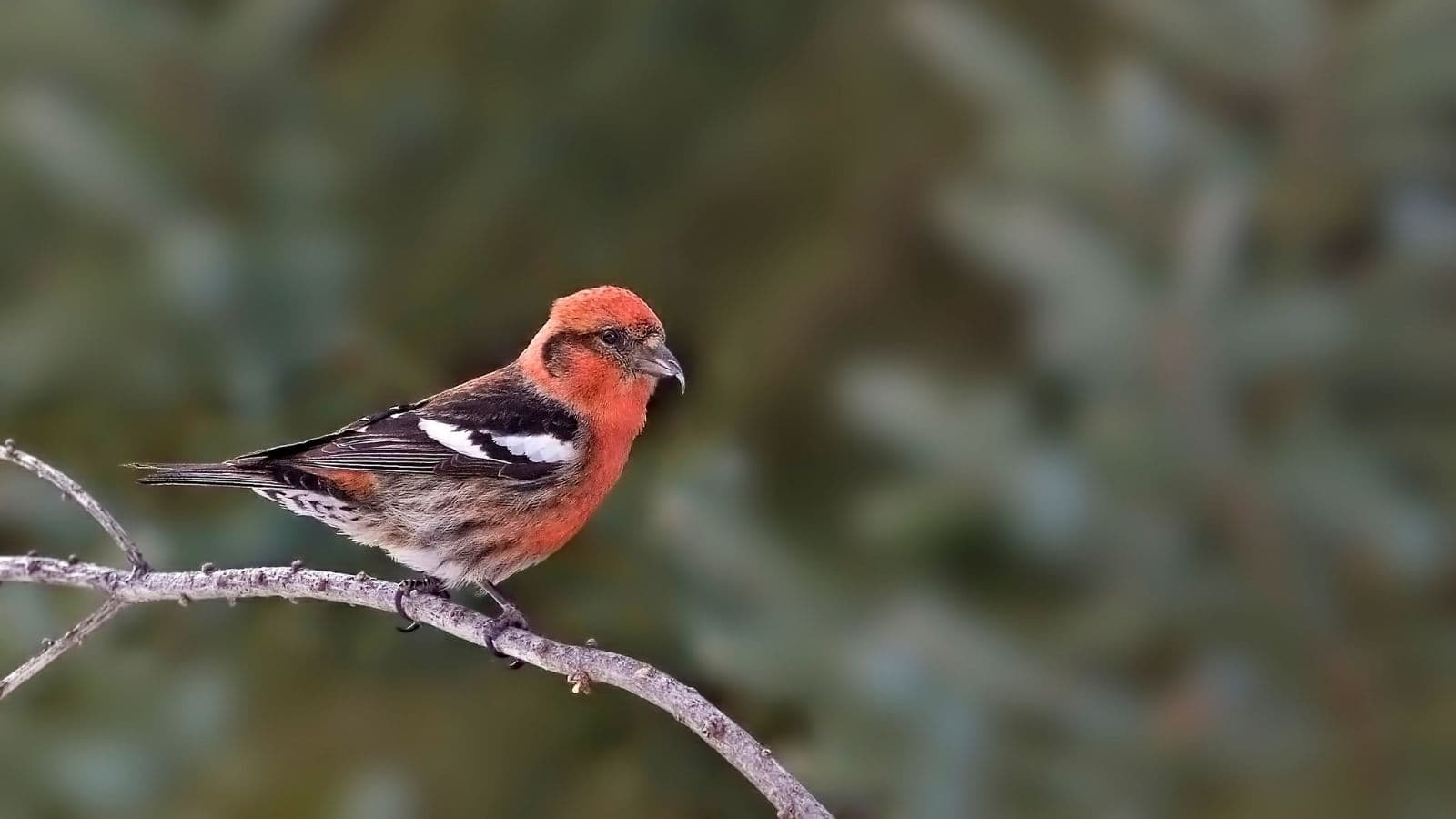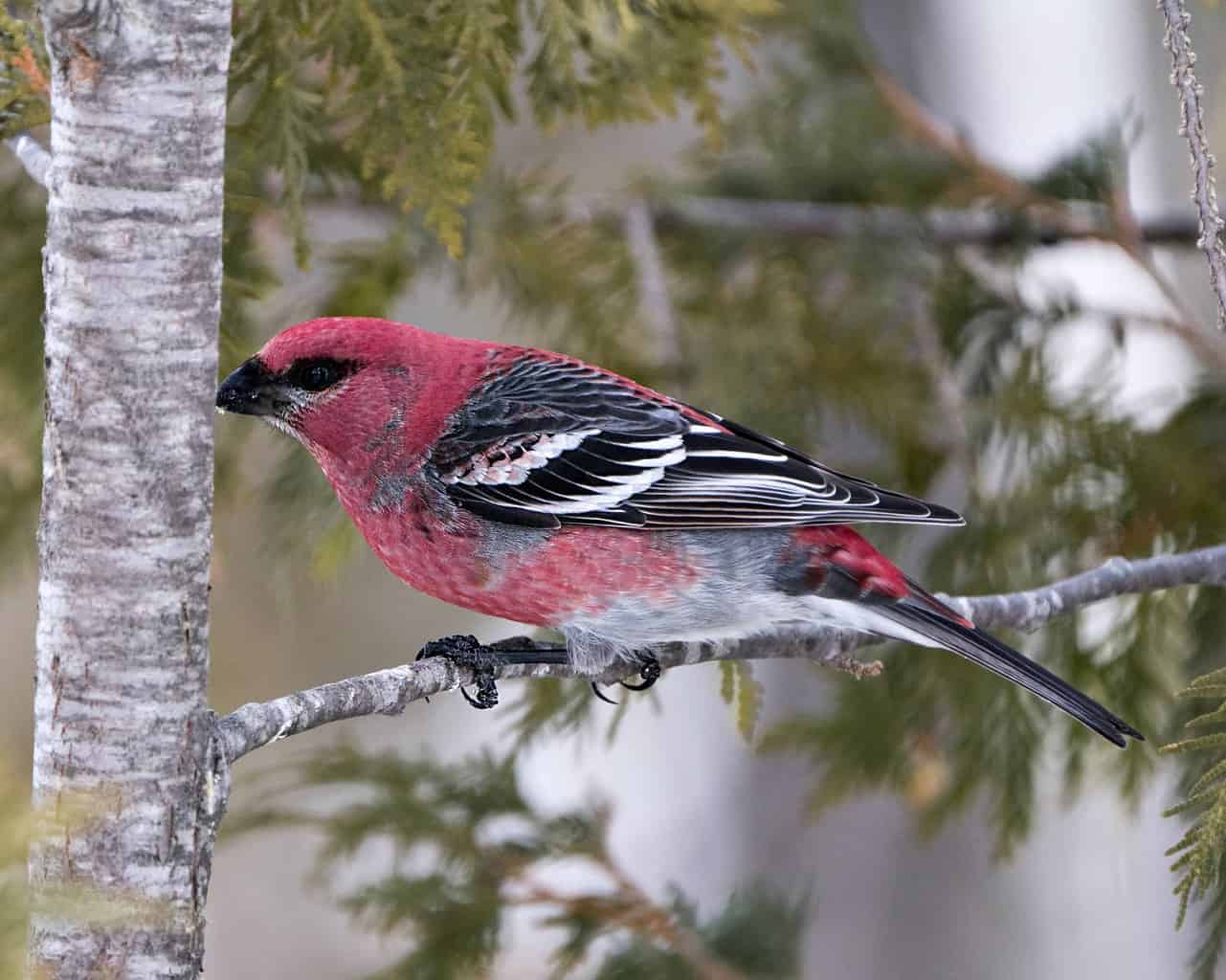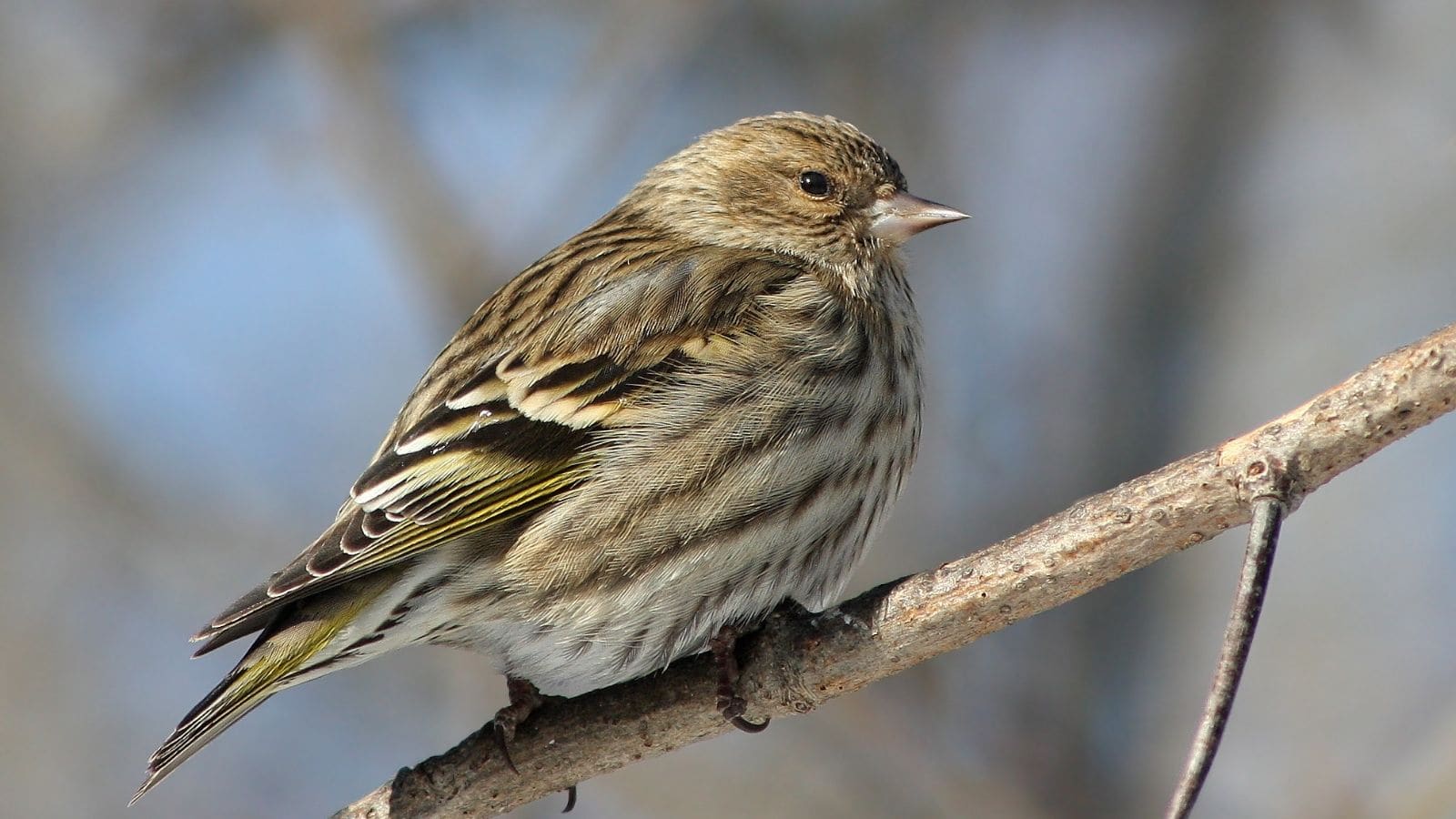Pennsylvania’s natural topography means it could easily be mistaken for a natural paradise with just under two-thirds of it filled with natural forest.
North America’s sixth most populous state also trumps all others in terms of navigable waterways with rivers which include the Allegheny, Delaware, and the Ohio among several others.
Add to that Lake Erie’s extensive waterline and it is easy to see why New York’s southern neighbor is a rather attractive prospect to not just humans, but birds too.
There are 439 bird species in Pennsylvania, 13 of which happen to be finches.
And if you are a fan of these varied little passerines, you will be able to find out which finch species call the Keystone State home, and which ones visit, if only for a while.
Brambling

- Scientific Name: Fringilla montifringilla
- Length: 6.2 inches
- Weight: 1 ounce
- Wingspan: 10 inches
This migratory species’ habitat of choice includes conifer and birch forests. Its male members can be recognized by a dark head suffused with orange and brown, an orange beak, and the presence of barring in black, brown, and orange beneath the nape.
Male bramblings also have an orange breast, black wing feathers edged with orange and white, as well as white upper and lower surfaces. Their heads, beaks, and upper surfaces turn black during the breeding season.
The plumage of female bramblings, on the other hand, is more muted, but also beautifully patterned. Although their faces are gray, their crowns are black and they also have a flush of orange on an otherwise white breast. Their wings also exhibit a similar pattern as those of their male counterparts.
Bramblings’ main excursions into the North American continent include visits to Alaska. However, visits to the contiguous United States are rare. Hence these beautiful birds are rarely seen in Pennsylvania.
Red Crossbill

- Scientific Name: Loxia curvirostra
- Length: 7.9 inches
- Weight: 2 ounces
- Wingspan: 12 inches
Red crossbills can be recognized by the presence of brick red plumage with coloring that is bolder in certain individuals and more muted in others. Females on the other hand are gray with hints of bronze at the chest.
Both genders have dark eyes, brown wings, and dark bills crossed over each other: the purpose of those beaks is to enable red crossbills to open pine and spruce cones with ease.
Red crossbills are rare winter visitors to Pennsylvania although they can be found in the north of New York, as well as West Virginia, and Virginia.
They can also be found in the western and southwestern United States.
White-Winged Crossbill

- Scientific Name: Loxia leucoptera
- Length: 6 – 7 inches
- Weight: 1 – 1.4 ounces
- Wingspan: 10.5 inches
Members of this species can be recognized by the presence of red plumage in males with black wings tipped with white. Females on the other hand exhibit prominent streaks and are mostly gray-brown although their wings have a similar pattern as their male counterparts’.
Both genders also share a characteristic crisscrossed beak and prefer living in woods with an abundance of spruce trees and tamaracks.
White-winged crossbills can be found in Canada. However, they may migrate as far south as Virginia in the eastern United States and Colorado in the southwest.
As a result, members of this species may be spotted in Pennsylvania during the winter months although such sightings are ultimately rare.
Lesser Goldfinch

- Scientific Name: Spinus psaltria
- Length: 3.5 – 5.0 inches
- Weight: 0.3 – 0.4 ounces
- Wingspan: 7.5 – 9 inches
Male lesser goldfinches can be recognized by their golden plumage. This contrasts with their black crowns and upper surfaces which may also be black or olive green. Dark wings streaked with white further accentuate their golden coloring.
Female lesser goldfinches have none of the bold contrasts of their male counterparts; they are colored in a rather delicate yellow. Although their wings exhibit similar patterns as males, they are brown rather than black, overall.
The species breeds in the Midwest and can also be found in the region throughout the year. Hence, lesser goldfinches are rarely found in Pennsylvania and any spotted are likely to be accidental visitors.
American Goldfinch

- Scientific Name: Spinus tristis
- Length: 4.3 – 5.5 inches
- Weight: 0.4 – 0.7 ounces
- Wingspan: 7.5 – 9 inches
American goldfinches are distinguishable owing to the presence of bright golden plumage in males which also wear a black cap at the crown. Dark wing and tail feathers which fade to white at their tips further add an appealing contrast to their colorful plumage.
And yet, by winter, that regal yellow is replaced by a less glamorous pale olive that brings them somewhat closer to the pale brown of their female counterparts.
American goldfinches are known for their habit of molting biannually and for feeding their young strictly vegetarian fare. The latter habit is one which does not bode well for brood parasites such as cowbirds whose young need animal protein.
Their range is pretty extensive and includes the entirety of the contiguous United States as well as southern Canada and northern Mexico.
American goldfinches can be found throughout the state of Pennsylvania all year long as well as neighboring New Jersey, New York, and Ohio.
They can be found in this capacity as far south as the state of Tennessee and even further south during winter.
Gray-Crowned Rosy-Finch

- Scientific Name: Leucosticte tephrocotis
- Length: 5.5 – 6.3 inches
- Weight: 0.8 – 2 ounces
- Wingspan: 13 inches
This species can be recognized by a black mask and plumage which is gray at the head turning a rich brown everywhere else. The gray-crowned rosy-finch is also named for the flush of pink which suffuses its chest and undersurface. That hint of rose is also present in its wing feathers which are dark brown-edged with gray.
A peculiar trait of these rosy finches is their habit of tending their young with the help of special throat pouches they develop when breeding with which they store food for their chicks.
The species breeds in Alaska, Yukon, and British Columbia in mountainous regions. It also spends most of its time in British Columbia and western Alberta.
Gray-crowned rosy-finches can also be found in the western United States in California, Idaho, Oregon, and Washington.
Members of this species are rarely found in Pennsylvania which lies outside their range in the United States.
Evening Grosbeak

- Scientific Name: Hesperiphona vespertina
- Length: 6 – 9 inches
- Weight: 1.4 – 3 ounces
- Wingspan: 12 – 14 inches
This species has been described as being similar to the hawfinch, another rather stoutly built passerine. However, in spite of a similarity in beak shape, and their overall size and form, they can be distinguished from each other promptly.
Hawfinches are a blend of brown, gray, and black. Evening grosbeaks on the other hand are covered in much bolder colors, particularly in males whose yellow facial markings above the eyes stand out against the dark brown of their heads. Their upper and underparts are yellow-brown, while their wing feathers form a white wedge surrounded by thick black edges.
Females are a delicate gray with a hint of yellow at their throats, and wings similar in pattern and color to those of their male counterparts.
Evening grosbeaks are rare winter visitors to the north of Pennsylvania. They spend most of their time in southern Canada and their range in this regard extends to the northwestern United States.
However, they may fly as far south as Texas and Florida during winter.
Pine Grosbeak

- Scientific Name: Pinicola enucleator
- Length: 9 inches
- Weight: 2 – 3 ounces
- Wingspan: 13 inches
Considered to be true finches, pine grosbeaks possess bold beaks which are typical of all avians belonging to this classification.
Males are a dark red color which is further accentuated by black wing feathers which fade to white at their edges.
Females, on the other hand, are olive at the head, chest, and rump, and gray elsewhere. They also exhibit the same wing colors and patterns as males.
Their name notwithstanding, members of this species enjoy a varied diet consisting of fruit, insects, and seeds.
They are known to be fond of berries, crabapples, and conifer seeds.
Pine grosbeaks can be found in Canada and the western United States. They may also fly as far south as central Pennsylvania during winter meaning they may be spotted on rare occasions in the state’s northern half.
House Finch

- Scientific Name: Haemorhous mexicanus
- Length: 5 – 6 inches
- Weight: 0.6 – 0.9 ounces
- Wingspan: 8 – 10 inches
Male house finches are dark brown in color and exhibit a striated pattern on their chests and underparts, while their wings are the same bold brown albeit with paler edges.
Owing to pigments obtained from their diet, their plumage is also flushed with red, orange, or yellow at the face, neck, and breast.
Females are paler in general, with lighter brown plumage at the head, and light brown streaks against a pale background at the breast.
This species which once occupied the western and southwestern United States six decades ago has since spread all over the nation.
House finches can be found all year round throughout Pennsylvania as a result, as well as its neighboring states.
Purple Finch

- Scientific Name: Haemorhous purpureus
- Length: 5 – 6 inches
- Weight: 0.4 – 0.6 ounces
- Wingspan: 7 – 9 inches
This species is easily mistaken for the more intrepid house finch. However, a closer glance will reveal its rather rounded head, completely covered in a red which tends towards pink, unlike the narrower head of the latter which has a flush of coloring that is often brick red.
Female purple finches are also covered in bolder colors compared to their house finch counterparts. The brown at their heads, wings, and upper surfaces is more intense as are the striations of the same color at the chest.
These passerines can be found in northern and central Pennsylvania all year round.
Common Redpoll

- Scientific Name: Acanthis flammea
- Length: 4.5 – 5.5 inches
- Weight: 0.4 – 0.5 ounces
- Wingspan: 8 – 9 inches
Common redpolls are small compact finches that prefer to live in northern Canada only flying southwards in winter.
Their southernmost range extends to the United States, just south of Pennsylvania in the east. These hardy little birds do visit the state. However, they only do so during the coldest seasons of the year and are by no means a common occurrence.
Members of the species are white shot through with brown. Their wing feathers are also brown and fade to white at the edges. Common redpolls also wear a dark red cap at the crown and their chests are suffused with a flush of pink.
Hoary Redpoll

- Scientific Name: Acanthis hornemanni
- Length: 5 – 5.5 inches
- Weight: 0.40 – 0.70 ounces
- Wingspan: 8 – 10 inches
At first glance, it might seem as though hoary and common redpolls are one and the same. But a closer peek reveals that while the former share the same blood-red crown, diminutive size, and compact build as the latter, their coloring is rather different.
Compared to common redpolls’ boldly striated plumage, hoary redpolls’ streaks and overall coloring are rather muted, although their wing feathers are brown and edged with white just like the formers’.
These hardy little avians are capable of withstanding even harsher climes compared to their cousins. Hoary redpolls’ breeding grounds lie in Alaska and Canada’s extreme north. The same applies to the locations where they can be found all year round.
However, members of this species may occasionally fly south and Pennsylvania’s northern border marks the southernmost extent of their range in this regard. As a result, hoary redpolls may be spotted within the state although such occasions are ultimately rare.
Pine Siskin

- Scientific Name: Spinus pinus
- Length: 4.3 – 5.5 inches
- Weight: 0.4 – 0.6 ounces
- Wingspan: 7 – 9 inches
Unlike several finch species where males are generally distinct from females, pine siskin males and females are rather similar. Both genders share the same gray-brown plumage along with those darker wings streaked boldly with yellow. The breasts of both males and females are also covered with bold dark streaks against a paler background.
However, the key difference lies in their tails with males’ being more colorful compared to females.’
These gregarious birds enjoy the seeds of alders, birches, eastern hemlocks, eastern white pines, and red spruces.
Pine siskins can be found all year round in Canada, the western United States, and Mexico. However, they can also be found throughout North America — Pennsylvania included — during winter. The sole exceptions are Texas’ southernmost point on the Gulf Coast and Florida’s southernmost tip.
Conclusion
Pennsylvania is home to 13 finch species most of which vary in their availability and location within the state and the wider United States as well.
For example, the American goldfinch and the house finch are especially widespread all year round throughout the state.
Although the purple finch can also be seen all year round, it is mainly confined to the state’s northern half.
Last of all come species that occasionally wander far beyond their usual breeding and feeding grounds, a category which includes the lesser goldfinch, the common redpoll, and the hoary redpoll.
No matter what time of the year it is in Pennsylvania, the likelihood of being pleasantly surprised by one of these passerines at a conifer close by is rather pretty high.

